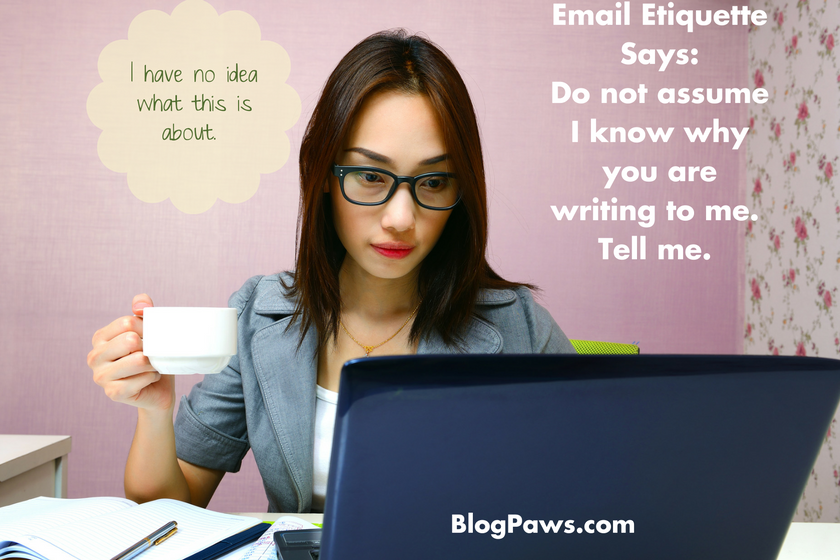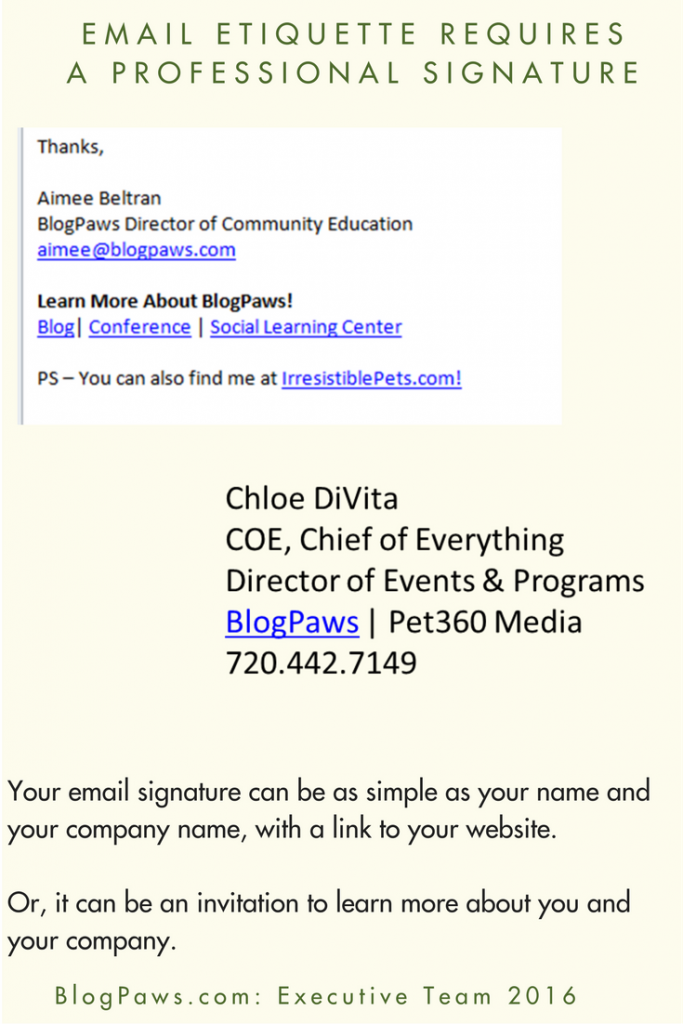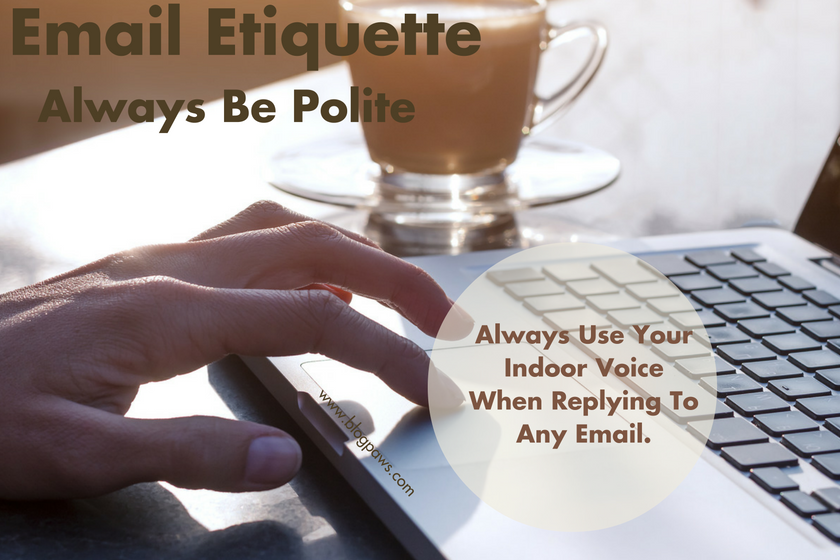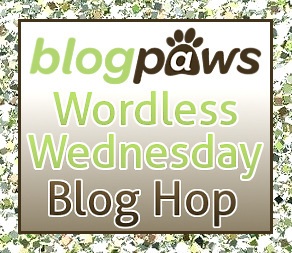The Etiquette of Email Communication
This post is not about email marketing, although the advice can easily apply to email marketing messages. I’m sharing this today because we are a digital society. We communicate via social media and email more than we do face-to-face, it seems. As an introvert, I do admit spending more time at my desk on my PC than out in the world where I should be. My apologies for not taking my own advice! I promise I am working on that! Let’s meet for coffee soon!
Because communication via email is inherently misunderstood (tone and voice are truly hard to convey in a written note online), those of us who rely on it need to be especially vigilant in our communication skills.
This post is about that vigilance in using email as a communications tool. To start, here are several reasons for connecting with someone via email:
- To share information
- To pitch a product or idea
- To convey a thought
- To say Thank You or Congratulations
I am sure you can think of others, but let’s discuss the etiquette of email communication as it applies to 1-3. I’ll assume you can handle #4 yourself.
When using email to share information or to pitch a product or an idea, ask yourself, “Is this the medium of choice for my audience?” In other words, do I, the recipient of your email, want this content cluttering up my email box? Might it be to your advantage to call me on the phone? Each of us has a preference on how we receive information and it’s your job to ask me how I want to receive your content. I may tell you outright, but if I haven’t, it’s incumbent upon you to ask. Thanks go to Katie Myers of CR Conversations for teaching me that!
Understand that pitches and/or ideas are generally welcomed if they are on point, short enough to read in less than one or two minutes, and include a specific action. Always include a proper salutation! Here’s an example I just made up:
Dear Yvonne,
I just started a new blog with a focus on my pet iguana. I noticed BlogPaws is an inclusive community and I wondered if that inclusiveness is also for lizards.
If it is, I think I might join your community! It’s for sure I need to learn more about this blogging thing and how to do it right!
I’m hoping you will reassure me iguanas are welcome in the BlogPaws community.
Thank you for your time today.
Julie Morrison, blogger at www.myiguanaBeeper.com
I would absolutely respond to Julie, invite her to the community (and link to it so she can click right through!), and thank her for asking.
When sending a reply to a reply–you send me a note and I reply then you reply–reference the question or concern of the original note. The nature of email is to deliver just what the sender writes, and while many email clients deliver previous content for your scrolling pleasure, some do not. And, sometimes, we know the long, scrolling note is unacceptable, so we start a new note, with a new subject line and expect the receiving party to ‘get it’. But, sometimes the receiving party, perhaps being busy with other things (ya think?), reads the new email note and scratches her head. “I have no idea what this is about,” she is thinking. It’s so easy to take one sentence or two and reference the reason for the note. Personally, I believe it’s better to over-inform than to under-inform.
For instance, if Julie, above, decides to reply to my note, which is a reply to her note, she should say, “Hi Yvonne, Julie here. We have been emailing about my new iguana blog and I have another question.” If she merely says, “Hi Yvonne, I have another question…” well, I might put her email aside because I don’t quite remember who she is, and… over the day, I might lose it or forget it.
Include a signature on all email communication. Too many bloggers fail to create a good signature to accompany their email messages. I may know you, and we may even have communicated previously. However, given the busy lives we all lead, a professional email signature helps to remind me who you are and what company/blog you are with. This is a foundation of email etiquette. See the examples here from our own BlogPaws Executive Team members, Aimee Beltran and Chloe DiVita. Two different, though similar, signatures. Note that Aimee includes a sign off, “thanks,” rather than just using her name. Chloe does this also, as do most of us at BlogPaws. It’s a polite way to sign off. We recommend it.
The last thing I will share about email etiquette today is to caution you about replying too quickly to any content that has upset you. If you’re angry or unhappy or confused or lost about something, and you click “reply” too soon, the note you write may be misinterpreted and may then cause more problems for you. Not to mention, if you give yourself 24 hours, you may have a completely different take on the issue. Take the time to pause, think, and if you feel strongly about responding, write your note but DO NOT SEND IT. Let it sit. When you re-read it later, I expect you will also either rewrite it or delete it.
Remember: Politeness is always more effective than shouting. Use your indoor voice. Be calm and take a moment to try and understand the sender’s purpose. If the sender was at fault for sending an inflammatory note, you do not have to respond in kind. Give the sender the benefit of the doubt before writing your note and clicking send. Despite what you may see here and there about recalling emails, once you send the note… it’s gone. You cannot recall it.
My last bit of advice on email etiquette is the “reply all” problem that is clogging so many email boxes across the entire world! Reply all serves one purpose – to inform a group of people. When those people have received the necessary information, it becomes necessary to remove them from any further or on-going conversations that no longer apply to the initial note. The key here is to be selective. Recognize when reply all is not the button to click. Use it sparingly. If a colleague or friend has included you in a reply all message that is now going on and on and on, for little reason you can see, I give you permission to opt out. Remove yourself from the list. Go ahead, do it. And, make it a lesson learned.
I would love to hear your questions or thoughts on email etiquette. A book I’ve been using as I work to be better at my email communication is, E-Writing: 21st Century Tools for Effective Communication by Dianna Booher. I recommend it. What books can you recommend?
Yvonne DiVita is a Co-Founder of BlogPaws. She is dedicated to storytelling and the human-animal bond. When not working on BlogPaws, she writes at Scratchings and Sniffings and The Lipsticking Society. You may contact her at Yvonne@blogpaws.com.
Images: Bohbeh/Shutterstock.com, NicoElNino/Shutterstock.com, and NicoElNino/Shutterstock.com






